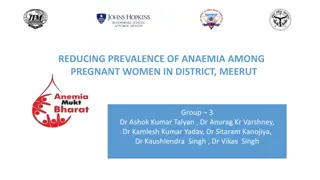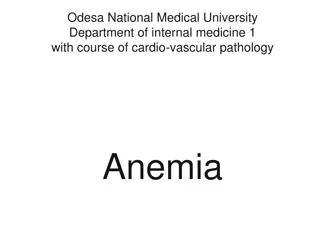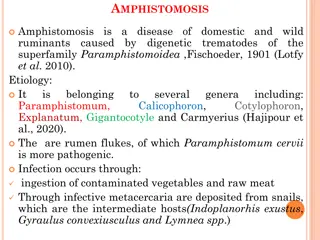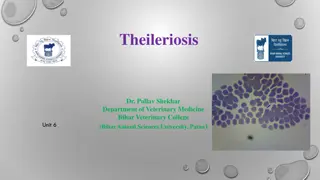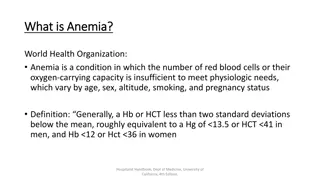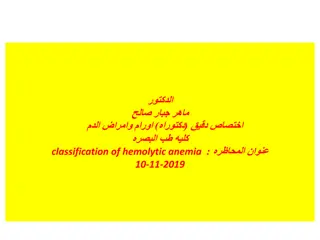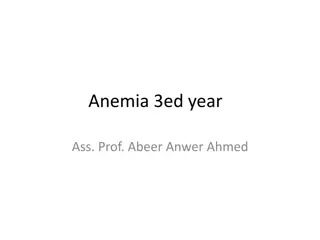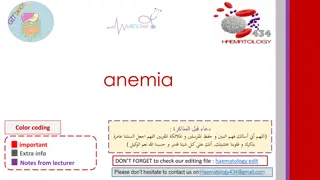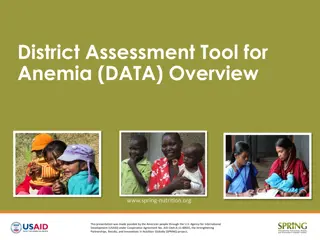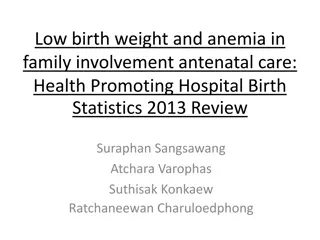Understanding Anemia: Causes, Symptoms, and Classification
Anemia is characterized by a reduction in hemoglobin (Hg) concentration, hematocrit (Hct) concentration, or red blood cell (RBC) count. Common symptoms include fatigue, weakness, dizziness, and palpitations. Physical signs may include pallor and tachycardia. Pica, characterized by unusual cravings, is also associated with anemia. Anemia can be classified based on the kinetic approach, which includes factors like RBC production, bone marrow disorders, and RBC destruction. Understanding the causes and symptoms of anemia is crucial for proper diagnosis and management.
Uploaded on Sep 15, 2024 | 0 Views
Download Presentation

Please find below an Image/Link to download the presentation.
The content on the website is provided AS IS for your information and personal use only. It may not be sold, licensed, or shared on other websites without obtaining consent from the author. Download presentation by click this link. If you encounter any issues during the download, it is possible that the publisher has removed the file from their server.
E N D
Presentation Transcript
Engin KELKTL MD 2020
What is Anemia? Anemia is defined by reduction in Hg Concentration, Hct Concentration or RBC count WHO criteria is Hg < 13 in men and Hg < 12 in women
Symptoms Common symptoms of anemia include decreased work capacity, fatigue, weakness, dizziness, palpitations, and dyspnea on exertion. Dyspnea Headaches Fatigue Roaring in the Ears Palpitations The severity of symptoms may vary widely depending on the degree of anemia, the time period over which anemia developed, the age of the patient, and other medical conditions that are present. PICA
Pica is characterized by an appetite for substances that are largely non-nutritive, such as ice (pagophagia); hair (trichophagia); paper (papyrophagia); drywall or paint; metal (metallophagia); stones (lithophagia) or soil (geophagia); glass (hyalophagia); or feces (coprophagia); and chalk
Physical signs of anemia Pallor Pallor is best noted in the conjunctiva, mucous membranes, palmar creases, and nail beds, Tachycardia, Increased cardiac impulse on palpation Systolic flow murmur heard at the apex and along the left sternal border,
Physical Manifestation : Spoon Nails in Iron Deficiency
CLASSIFICATION OF ANEMIA Anemia can be approached from two perspectives:
Kinetic Approach Decreased RBC production Lack of nutrients (B12, folate, iron) Bone Marrow Disorder Bone Marrow Suppression Increased RBC destruction Inherited and Acquired Hemolytic Anemias Blood Loss
Morphological Approach Microcytic (MCV < 80) Reduced iron availability Reduced heme synthesis Reduced globin production Normocytic ( 80 < MCV < 100) Macrocytic (MCV > 100) Liver disease, B12, folate
Reticulocyte Count: The reticulocyte count is the proportion (percent) of young erythrocytes containing ribonucleic acid (RNA), which can be visually identified as reticulin using a special stain such as new methylene blue. The normal reticulocyte count is approximately 1%. Increased reticulocyte count is the primary indicator of increased RBC production.
Example: A patient is found to have a hematocrit of 15% and reticulocyte count of 10%. Calculate the corrected reticulocyte count: Corrected reticulocyte count = 10 . (15:45) = 3.3%
Peripheral blood smear Manual examination of a peripheral blood sample under a microscope May reveal classic pathologic RBC forms, which can be used to identify certain types of anemia that automated RBC indices cannot (e.g., schistocytes in hemolytic anemia)
SUMMARY Anemia is defined as a decrease in the quantity of circulating red blood cells (RBC), represented by a reduction in hemoglobin concentration (Hb), hematocrit (Hct), or RBC count. Clinical features, if present, are mostly nonspecific and may include fatigue, dyspnea, conjunctival pallor, and tachycardia. Once anemia has been established, the mean corpuscular volume (MCV) should be checked to distinguish between microcytic, normocytic, and macrocytic anemia and to determine the next diagnostic steps. A peripheral blood smear allows for the identification of pathologic RBC forms. Reticulocyte count can also be used to evaluate the bone marrow response. Treatment depends on the form of anemia and underlying condition. Acute and/or severe cases of anemia may require transfusion of packed red blood cells.




